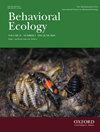母性投资和早期热条件影响动物的表现和反捕食者反应
IF 2.2
3区 环境科学与生态学
Q2 BEHAVIORAL SCIENCES
引用次数: 0
摘要
在一系列外温动物的早期发育过程中,暴露于升高的温度会导致其形态、生理和行为的表型可塑性。此外,已知母体效应也是导致后代表型变异的重要因素。至于这两个因素是否会相互作用,进而塑造后代的形态和行为,目前还很少有人进行研究。这一点至关重要,因为气候变化预计会影响孵化温度、母体资源分配和压力水平。利用全因子设计和贝叶斯多元混合模型,我们探讨了对早期热环境和卵中卵黄数量的控制如何影响两种同域澳大利亚石龙子(Lampropholis delicata和L. guichenoti)的形态、表现和反捕食行为。我们发现,在L. guichenoti中,热处理的幼体比冷处理的大,而在L. delicata中则不然。通过对蜥蜴个体的重复行为测量,我们发现孵化温度与母体对蜥蜴表现的投资之间存在交互作用。我们预测,母体的行为表现变化会影响蜥蜴的反捕食反应。为了支持这一预测,我们发现母性投资对反捕食行为有影响,在模拟捕食攻击后,卵黄减少和低温处理的动物恢复活动的速度更快。然而,这一预测在L. guichenoti中并不成立。我们的研究结果凸显了探索环境在不同世代中发挥的多方面作用的重要性,从而了解不同的人为因素在未来将如何影响野生动物。本文章由计算机程序翻译,如有差异,请以英文原文为准。
Maternal investment and early thermal conditions affect performance and antipredator responses
Exposure to increased temperatures during early development can lead to phenotypic plasticity in morphology, physiology, and behaviour across a range of ectothermic animals. In addition, maternal effects are known to be important contributors to phenotypic variation in offspring. Whether the two factors interact to shape offspring morphology and behaviour has been barely explored. This is critical since climate change is expected to impact both incubation temperature and maternal resource allocation and stress levels. Using a fully-factorial design, and Bayesian multivariate mixed models, we explored how the manipulation of early thermal environment and yolk-quantity in eggs affected the morphology, performance and antipredator behaviour of two sympatric Australian skink species (Lampropholis delicata and L. guichenoti). We found that juveniles from the hot treatment were larger than those on the cold treatment in L. guichenoti but not L. delicata. Using repeated behavioural measures for individual lizards, we found an interaction between incubation temperature and maternal investment in performance, with running speed being affected in a species-specific way by the treatment. We predicted that changes in performance should influence antipredator responses. In support of this prediction, we found that maternal investment impacted antipredator behaviour, with animals from the yolk-reduced and cold treatment resuming activity faster after a simulated predatory attack in L. delicata. However, the prediction was not supported in L. guichenoti. Our results highlight the importance of exploring the multifaceted role that environments play across generations to understand how different anthropogenic factors will impact wildlife in the future.
求助全文
通过发布文献求助,成功后即可免费获取论文全文。
去求助
来源期刊

Behavioral Ecology
环境科学-动物学
CiteScore
5.20
自引率
8.30%
发文量
93
审稿时长
3.0 months
期刊介绍:
Studies on the whole range of behaving organisms, including plants, invertebrates, vertebrates, and humans, are included.
Behavioral Ecology construes the field in its broadest sense to include 1) the use of ecological and evolutionary processes to explain the occurrence and adaptive significance of behavior patterns; 2) the use of behavioral processes to predict ecological patterns, and 3) empirical, comparative analyses relating behavior to the environment in which it occurs.
 求助内容:
求助内容: 应助结果提醒方式:
应助结果提醒方式:


